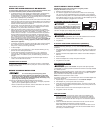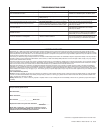
HOW CAN I PROTECT MY FAMILY FROM CO
POISONING?
A CO Alarm is an excellent means of protection. It monitors the air and sounds
a loud alarm befor
e Carbon Monoxide levels become threatening for average,
healthy adults.
A CO Alar
m is not a substitute for proper maintenance of home appliances.
T
o help prevent CO problems and reduce the risk of CO poisoning:
•
Clean chimneys and flues yearly. Keep them free of debris, leaves, and
nests for pr
oper air flow. Also, have a professional check for rust and
corrosion, cracks, or separations. These conditions can prevent proper
air movement and cause backdrafting. Never “cap” or cover a chimney
in any way that would block air flow
.
• Test and maintain all fuel-burning equipment annually. Many local gas or
oil companies and HV
AC companies offer appliance inspections for a
nominal fee.
• Make regular visual inspections of all fuel-burning appliances. Check
appliances for excessive rust and scaling. Also check the flame on the
burner and pilot lights. The flame should be blue. A yellow flame means
fuel is not being burned completely and CO may be present. Keep the
blower door on the fur
nace closed. Use vents or fans when they are
available on all fuel-burning appliances. Make sure appliances are
vented to the outside. Do not grill or barbecue indoors, or in garages
or on scr
een porches.
• Check for exhaust backflow from CO sources. Check the draft hood on
an operating fur
nace for a backdraft. Look for cracks on furnace heat
exchangers.
• Check the house or garage on the other side of shared wall.
• Keep windows and doors open slightly. If you suspect that CO is
escaping into your home, open a window or a door. Opening windows
and doors can significantly decr
ease CO levels.
In addition, familiarize yourself with all enclosed materials. Read this
manual in its entirety, and make sure you understand what to do if your
CO Alarm sounds.
REGULATORY INFORMATION FOR CO ALARMS
REGULATORY INFORMATION FOR CO ALARMS
WHAT LEVELS OF CO CAUSE AN ALARM?
Underwriters Laboratories Inc. Standard UL2034 requires residential CO
Alarms to sound when exposed to levels of CO and exposure times as
described below. They are measured in parts per million (ppm) of CO over
time (in minutes).
UL2034 Required Alarm Points*:
• If the alarm is exposed to 400 ppm of CO, IT MUST ALARM BETWEEN
4 and 15 MINUTES.
• If the alarm is exposed to 150 ppm of CO, IT MUST ALARM BETWEEN
10 and 50 MINUTES.
• If the alarm is exposed to 70 ppm if CO, IT MUST ALARM BETWEEN
60 and 240 MINUTES.
* Approximately 10% COHb exposure at levels of 10% to 95% Relative
Humidity (RH).
The unit is designed not to alarm when exposed to a constant level of 30 ppm
for 30 days.
CO Alarms are designed to alarm before there is an immediate life threat.
Since you cannot see or smell CO, never assume it’s not present.
•
An exposur
e to 100 ppm of CO for 20 minutes may not af
fect average,
healthy adults, but after 4 hours the same level may cause headaches.
•
An exposur
e to 400 ppm of CO may cause headaches in average, healthy
adults after 35 minutes, but can cause death after 2 hours.
Standards: Underwriters Laboratories Inc. Single and Multiple Station carbon
monoxide alarms UL2034.
Accor
ding to Underwriters Laboratories Inc. UL2034, Section 1-1.2: “Carbon
monoxide alarms covered by these requirements are intended to respond to
the pr
esence of carbon monoxide fr
om sources such as, but not limited to,
exhaust from internal-combustion engines, abnormal operation of fuel-fired
appliances, and fireplaces. CO Alarms are intended to alarm at carbon
monoxide levels below those that could cause a loss of ability to r
eact to the
dangers of Carbon Monoxide exposure.” This CO Alarm monitors the air at the
Alarm, and is designed to alarm before CO levels become life threatening. This
allows you precious time to leave the house and correct the problem. This is
only possible if Alarms ar
e located, installed, and maintained as described in
this manual.
Gas Detection at Typical Temperature and Humidity Ranges: The CO
Alarm is not formulated to detect CO levels below 30 ppm typically
.
Audible Alarm: 85 dB minimum at 10 feet (3 meters).
GENERAL LIMIT
ATIONS OF CO ALARMS
This CO Alarm is intended for residential use. It is not intended for use in
industrial applications wher
e Occupational Safety and Health Administration
(OSHA) r
equirements for Carbon Monoxide Alarms must be met. This device
is not intended to alert hearing impaired residents.
CO Alarms may not waken all individuals. If children or others do not readily
waken to the sound of the CO Alarm, or if ther
e are infants or family members
with mobility limitations, make sur
e that someone is assigned to assist them in
the event of an emergency.
This CO Alarm will not sense CO that does not reach the sensors. It will
only sense CO at the sensor
. CO may be present in other areas. Doors or
other obstructions may affect the rate at which CO reaches the sensors.
CO Alarms may not be heard. The alarm horn loudness meets or exceeds
current UL standards of 85 dB at 10 feet (3 meters). However, if the CO Alarm
is installed outside the bedr
oom, it may not wake up a sound sleeper or one
who has recently used drugs or has been drinking alcoholic beverages. This
is especially true if the door is closed or only partly open. Even persons who
ar
e awake may not hear the alarm horn if the sound is blocked by distance or
closed doors. Noise from traffic, stereo, radio, television, air conditioner, or
other appliances may also prevent alert persons from hearing the alarm horn.
This CO Alarm is not intended for people who ar
e hearing impaired.
This CO Alar
m is not a substitute for life insurance.
Though this CO Alarm
warns against increasing CO levels, BRK Brands, Inc. does not warrant or
imply in any way that they will pr
otect lives. Homeowners and renters must
still insur
e their lives.
This CO Alar
m is not foolproof.
Like all other electr
onic devices, this CO
Alarm has limitations. It can only detect CO that reaches the sensors. It may
not give early war
ning if the source of CO is in a remote part of the home,
away from the alarm device.
This CO Alar
m has a limited life.
Although this CO Alarm and all of its
parts have passed many stringent tests and ar
e designed to be as reliable as
possible, any of these parts could fail at any time. Ther
efore, you must test this
device weekly. The unit should be replaced immediately if it is not operating
properly.
6























